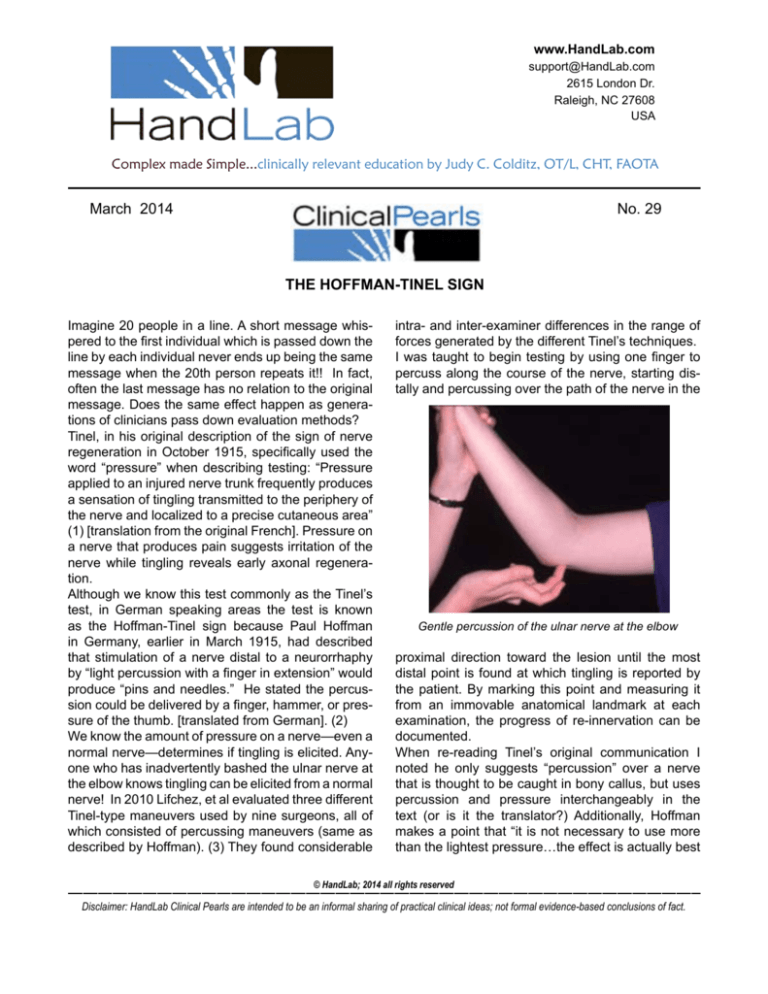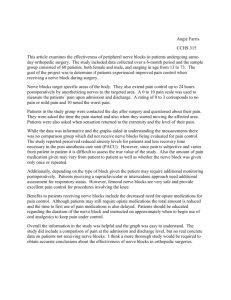
www.HandLab.com
support@HandLab.com
2615 London Dr.
Raleigh, NC 27608
USA
Complex made Simple...clinically relevant education by Judy C. Colditz, OT/L, CHT, FAOTA
March 2014
No. 29
THE HOFFMAN-TINEL SIGN
Imagine 20 people in a line. A short message whispered to the first individual which is passed down the
line by each individual never ends up being the same
message when the 20th person repeats it!! In fact,
often the last message has no relation to the original
message. Does the same effect happen as generations of clinicians pass down evaluation methods?
Tinel, in his original description of the sign of nerve
regeneration in October 1915, specifically used the
word “pressure” when describing testing: “Pressure
applied to an injured nerve trunk frequently produces
a sensation of tingling transmitted to the periphery of
the nerve and localized to a precise cutaneous area”
(1) [translation from the original French]. Pressure on
a nerve that produces pain suggests irritation of the
nerve while tingling reveals early axonal regeneration.
Although we know this test commonly as the Tinel’s
test, in German speaking areas the test is known
as the Hoffman-Tinel sign because Paul Hoffman
in Germany, earlier in March 1915, had described
that stimulation of a nerve distal to a neurorrhaphy
by “light percussion with a finger in extension” would
produce “pins and needles.” He stated the percussion could be delivered by a finger, hammer, or pressure of the thumb. [translated from German]. (2)
We know the amount of pressure on a nerve—even a
normal nerve—determines if tingling is elicited. Anyone who has inadvertently bashed the ulnar nerve at
the elbow knows tingling can be elicited from a normal
nerve! In 2010 Lifchez, et al evaluated three different
Tinel-type maneuvers used by nine surgeons, all of
which consisted of percussing maneuvers (same as
described by Hoffman). (3) They found considerable
intra- and inter-examiner differences in the range of
forces generated by the different Tinel’s techniques.
I was taught to begin testing by using one finger to
percuss along the course of the nerve, starting distally and percussing over the path of the nerve in the
Gentle percussion of the ulnar nerve at the elbow
proximal direction toward the lesion until the most
distal point is found at which tingling is reported by
the patient. By marking this point and measuring it
from an immovable anatomical landmark at each
examination, the progress of re-innervation can be
documented.
When re-reading Tinel’s original communication I
noted he only suggests “percussion” over a nerve
that is thought to be caught in bony callus, but uses
percussion and pressure interchangeably in the
text (or is it the translator?) Additionally, Hoffman
makes a point that “it is not necessary to use more
than the lightest pressure…the effect is actually best
© HandLab; 2014 all rights reserved
Disclaimer: HandLab Clinical Pearls are intended to be an informal sharing of practical clinical ideas; not formal evidence-based conclusions of fact.
www.HandLab.com
support@HandLab.com
2615 London Dr.
Raleigh, NC 27608
USA
Complex made Simple...clinically relevant education by Judy C. Colditz, OT/L, CHT, FAOTA
March 2014
No. 29
THE HOFFMAN-TINEL SIGN, continued
when stimulation is applied by light percussion with
the finger applied in extension (the opposite of the
technique otherwise used for percussion).” Since
Hoffman seems to differentiate between “pressure”
and “percussion,” I now question whether I should
change my method of examination, although Hoffman describes the test using one finger for “percussion.” Should I continue to percuss gently along the
path of the nerve or should I press gently along the
path of the nerve? Does it even matter?
The method of the Hoffman-Tinel testing has been
whispered down the line of clinicians for almost 100
years so perhaps we need to return to the original descriptions and start again to define standards for the
testing procedure. At the very least it would be helpful to know if a varied amount of pressure (whether
pressure or percussion) makes any difference. So I
must agree with Lifchez and colleagues: There is no
standardization for eliciting the Tinel-Hoffman sign!!!
If anyone has particular insight on this topic we would
be eager to hear from you.
1. Tinel, J [translated by Emanuel B.Kaplan].
“The “Tingling” Sign in Pheripheral Nerve Lesions.”
Injuries to the major branches of peripheral nerves
of the forearm. Ed. Morton Spinner. 2nd ed. Philadelphia: W.B. Saunders, 1978. 8-13.
2. Buck-Gramcko D, Lubahn J. The HoffmanTinel sign. J Hand Surg [Br] 18B (1993): 800-805.
3. Lifchez SD, et al. “Intra- and inter-examiner
variability in performing Tinel’s test.” J Hand Surg
[Am] 35.2 (2010): 212-16.
© HandLab; 2014 all rights reserved
Disclaimer: HandLab Clinical Pearls are intended to be an informal sharing of practical clinical ideas; not formal evidence-based conclusions of fact.








